You're here because you want to know how to build a SaaS product that stands out in a crowded market. This isn’t just another guide. At Greenice web development agency, we specialize in custom SaaS development, bringing years of expertise across industries—from healthcare to construction. We’ve designed a clear, actionable pathway for entrepreneurs like you who are ready to move from idea to action—without the fluff.
In this guide, we'll cut through the noise with practical steps and insider tips that cover everything from initial concept validation to choosing the right technology stack and scaling your business. You’ll learn how to make money with SaaS and how to build a SaaS app for just $10K.
By the end of this article, you won’t just understand the essentials; you'll have a specific plan for navigating the complexities of the SaaS world and avoiding the common pitfalls that snag most startups.
Dive in to transform your dream into a scalable, profitable reality with guidance from seasoned professionals.
What is SaaS and how does it differ from other software?
Software as a Service (SaaS) changes software delivery by providing applications over the internet, allowing users to access them anytime and anywhere without the need for installation or maintenance. This model not only simplifies access from any device but also significantly reduces costs associated with purchasing, installing, and maintaining software systems. Notable SaaS providers include Salesforce, SAP, Zoom, and Adobe, offering a range of services from customer relationship management to creative tools.
SaaS differs from traditional on-premise software primarily in its deployment and accessibility. It operates on a pay-as-you-go basis, enhancing flexibility for users who pay only for the services they consume. SaaS applications are supported by cloud storage, ensuring data security and supporting scalable, multi-tenant architectures.
Architecture is a crucial aspect of SaaS. In multi-tenant SaaS environments, a single instance of the application serves multiple customers, with each tenant's data securely stored and isolated in the cloud. This setup significantly reduces costs since resources are shared and the need for separate physical installations is eliminated.
Moreover, SaaS platforms are designed to easily integrate with other applications via APIs, enhancing functionality and allowing users to perform various tasks seamlessly. This integration capability is often a competitive advantage, enabling tasks like automating billing and integrating with other digital tools which can be more cumbersome in traditional software setups.
These features collectively make SaaS a more scalable, cost-effective, and adaptable solution compared to on-premise software, particularly suitable for businesses seeking efficient, innovative technology solutions.
Let’s look at what business domains SaaS can come in handy.
Types of SaaS applications:
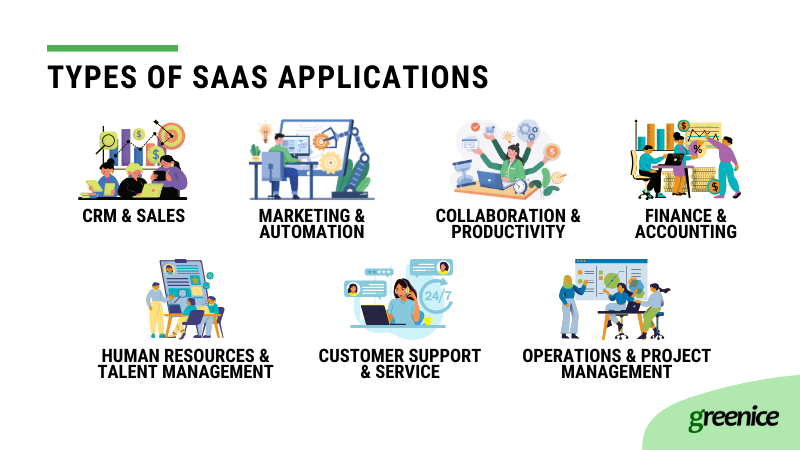
- CRM & sales: Tools like Salesforce, Pipedrive, and HubSpot streamline customer relationship management and sales processes, helping businesses manage their customer interactions more efficiently.
- Marketing & automation: Platforms such as Marketo, Mailchimp, and HubSpot aid in automating marketing tasks and enhancing digital marketing efforts.
- Collaboration & productivity: Solutions like Slack, Asana, and Trello enhance team collaboration and project management, improving workplace productivity.
- Finance & accounting: Applications such as QuickBooks Online and Xero offer comprehensive solutions for managing business finances, from invoicing to accounting.
- Human resources & talent management: Tools like Workday and BambooHR provide robust HR management features, including payroll, benefits administration, and employee records management.
- Customer support & service: Platforms like Zendesk and Freshdesk improve customer service operations with ticketing, customer support, and engagement tools.
- Operations & project management: Solutions such as Monday.com, Jira, and Wrike facilitate project planning, tracking, and execution, catering to various operational needs.
Before building SaaS applications, let’s explore if this is a profitable business.
Why create a SaaS in 2025?
As of 2023, the global SaaS market reached approximately $197 billion in revenue, demonstrating the robust appetite for cloud-based solutions. The market is expected to continue to grow, projected to reach a staggering $716 billion by 2028. This growth is fueled by the continuous adoption of cloud services, with 70% of total company software now being SaaS applications, according to BetterCloud.
More reasons to create a SaaS now:
- Massive adoption: With businesses integrating SaaS at an unprecedented rate, service providers enjoy steady, recurring revenue from subscriptions and upgrades. In 2025 spending on public cloud services are expected to reach $299 billion, highlighting the expanding demand.
.png)
- COVID-19 impact: The pandemic accelerated remote work, pushing a 64% rise in cloud service usage since 2019, a trend set to continue post-pandemic.
- Customer preference: Businesses favor SaaS for its cost-effectiveness, scalability, and ease of disaster recovery. SaaS solutions provide a flexible, agile, and convenient alternative to traditional software installations.
- Innovation and acquisition opportunities: Despite a crowded market, there remains space for innovative solutions in both broad and niche segments. SaaS startups frequently attract acquisition by larger tech companies, eager to integrate new technologies into their offerings.
- Security focus: With encryption concerns topping SaaS-related security issues, there is a significant opportunity for new entrants who can offer robust security features.
The robust growth of the SaaS sector, coupled with its critical role in modern business operations, makes now an opportune time to create Software as a Service. Whether targeting a broad audience or focusing on a micro-niche, SaaS developers can find numerous opportunities to innovate and succeed in this vibrant market.
SaaS trends
The SaaS sector embraces new technologies and adapts to the changing needs of businesses across various industries. Here are some of the most significant current trends to give a thought while developing saas applications:
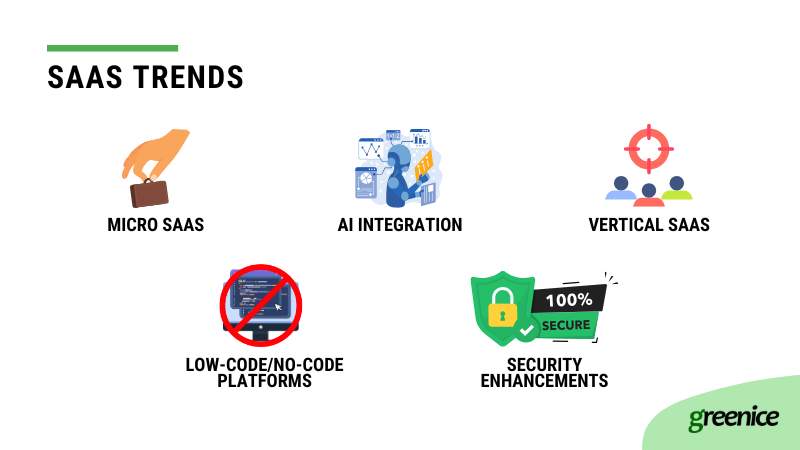
- Micro SaaS: The Micro SaaS trend is increasingly popular among small teams and solo developers who launch specialized solutions for niche markets. These products are designed to address specific customer needs effectively and affordably, ensuring high functionality with low operational costs. This trend enables the rapid deployment and customization of services, catering precisely to the evolving demands of targeted industries.
- AI integration: AI is becoming increasingly integral to SaaS applications, enhancing capabilities in automation, predictive analytics, and personalized customer experiences. By 2030, the AI SaaS market is expected to hit $1547.57 billion. AI can automate repetitive tasks, provide insightful data analysis, and even drive decision-making processes, thereby increasing efficiency and effectiveness across various SaaS platforms.
- Vertical SaaS: The rise of Vertical SaaS is driven by the overcrowded market of universal SaaS solutions. Vertical SaaS offers a more targeted approach, focusing on specific industries, tailoring functionalities to meet the unique requirements, workflows, and compliance standards of those sectors. By concentrating on niche markets where competition is less intense, business owners can achieve deeper integration into their clients' operations and provide more targeted solutions, setting themselves apart in a crowded marketplace.
- Low-code/No-code platforms: These platforms are transforming SaaS by enabling users without technical expertise to build applications, automate workflows, and integrate various systems without writing code. This democratization of development empowers more users to create custom solutions quickly and cheaply.
- Security enhancements: As data breaches become more common, SaaS providers are investing heavily in advanced security measures. This includes everything from enhanced encryption practices to AI-driven threat detection systems, ensuring that customer data is protected against an evolving landscape of cyber threats.
Challenges of SaaS development
When considering how to build a SaaS application, it's crucial to understand and navigate the myriad challenges you may encounter during the development process. Here are some of the key challenges:
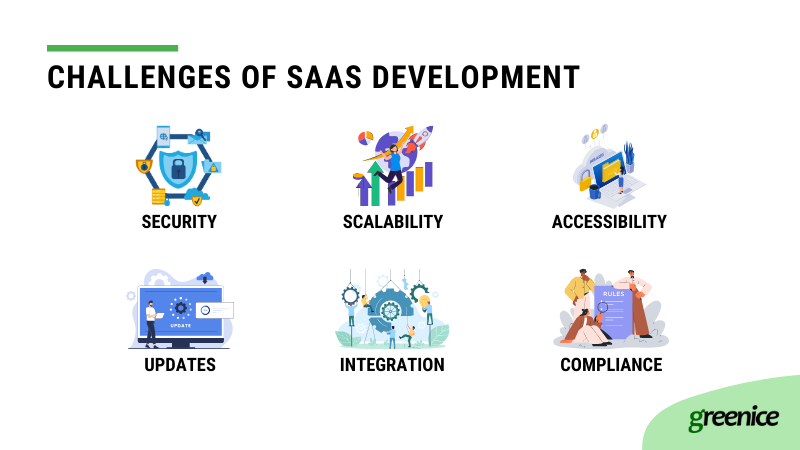
- Security and confidentiality: As SaaS systems often handle sensitive customer data, including information about business processes and finances, security is a paramount concern. Employing robust cloud solutions like AWS can enhance data security. These platforms ensure that each tenant's data is isolated and can only be accessed via unique identifiers, preventing data mix-ups between different organizations.
- Scalability: SaaS applications need to offer various scalability options tailored to user needs, which may vary by the number of users, feature access, and other parameters. Cloud environments like AWS facilitate scalability by allowing you to adjust server capacities dynamically—scaling up or down as needed. This flexibility ensures that you only pay for the resources you use, which is particularly beneficial for managing costs in a growth phase.
- Feature accessibility: The architecture of a SaaS should be flexible enough to enable or disable features based on the user's subscription plan. This requires a dynamic setup where features not included in a user's package are automatically deactivated, ensuring that users only access what they pay for.
- System updates: Regular updates are essential for maintaining security and compatibility. Unlike traditional software models, where updates might require manual installation from new disks or downloads, SaaS allows for seamless, automated updates online. This model ensures that all users have immediate access to the latest features and security enhancements without disrupting their ongoing operations.
- Integration with other systems: Integrating a SaaS application with existing systems and third-party services can be complex. Ensuring compatibility and seamless operation between different systems—such as legacy systems, CRM software, or financial applications—requires robust API management and careful planning to prevent data silos and ensure efficient workflows.
- Compliance and regulatory requirements: Depending on the industry and the type of data handled, SaaS applications may need to comply with various legal and regulatory standards such as GDPR, HIPAA, or SOC 2. Compliance involves ensuring data protection, secure data handling, and proper audit trails, which can significantly complicate the development and operational processes.
Remember these challenges while building a SaaS product, and think on how you can overcome them.
How to build a SaaS application step-by-step?
Building a SaaS platform begins with an idea. Then what? Many projects remain on the drawing board because their owners do not know how to nurse the idea from start to finish. Starting a SaaS company, use our detailed guide to help you quickly move to the launch stage! Here are the steps to take:
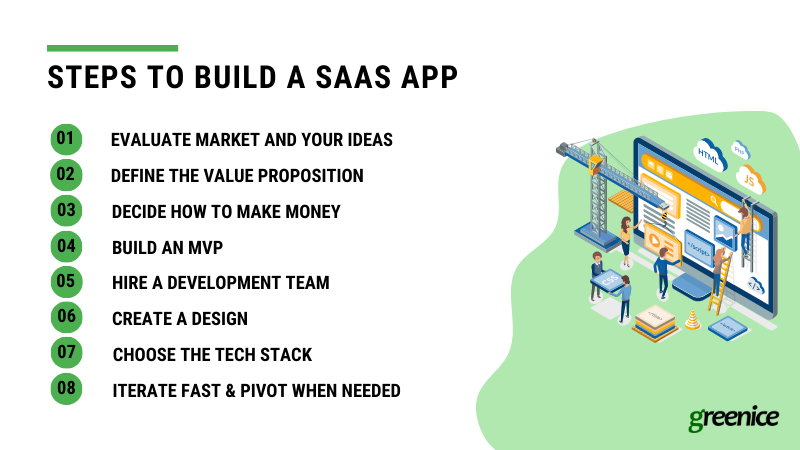
1. Evaluate market and your idea
As you navigate the initial stages of developing your SaaS concept, conducting a Discovery phase is crucial. This phase involves deepening your understanding of the market, competitors, and potential customers through meticulous research and analysis.
Ask yourself these questions:
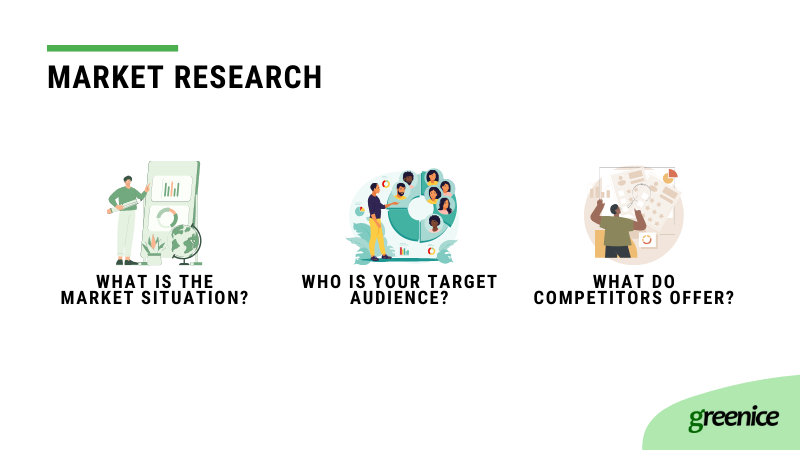
- What is the market situation? Start with a thorough investigation of the industry. Assess the demand for products similar to what you plan to develop and identify your main competitors. This research should uncover recent trends in SaaS and potential gaps in the market that your product could potentially exploit.
For example: “The market for project management tools is expanding, particularly for software that supports remote and distributed teams. While established players like Asana and Trello offer robust features, there is a gap in solutions that integrate project management with real-time communication and advanced analytics tailored for remote operations.”
- Who is your target audience? Define who will benefit most from your product. Detail their specific challenges, needs, and behavior patterns. Utilize methods such as interviews and surveys to validate that the issue your product addresses is critical to your target demographic.
For example: “Our primary target audience includes small to medium-sized businesses with remote teams. These teams require tools that not only facilitate project management but also support seamless communication and integration across different time zones and platforms.”
- What do competitors offer? Carefully analyze the products already available in the market. Examine what these products do well and where they fall short. Understanding these aspects will assist you in defining how your product will differ and the unique solutions it will provide.
For example: “Competitors provide strong project management features but often lack comprehensive, integrated communication functions. Most require additional integrations for features like real-time messaging and video calls, which can disrupt user experience and workflow efficiency. Our product aims to fill this gap by offering an all-in-one solution.”
2. Define the value proposition
A strong value proposition clarifies why customers should choose your product over others. It answers the fundamental question: "Why should customers buy our product?" It communicates the unique benefits and the real-world impact your SaaS product delivers, making it compelling and relevant to your target audience.
To craft your value proposition:
- Identify the product's core benefits: Start by understanding the primary advantages your product offers. Focus on the results or transformations your customers will experience rather than just the features.
- Streamline your marketing strategy: Start by identifying the Total Addressable Market (TAM) to understand the broadest potential customer base and market demand. Refine this into your Ideal Customer Profile (ICP), targeting businesses or segments that best match your product’s features, considering factors like industry and company size. Finally, develop detailed Buyer Personas from the ICP, profiling typical decision-makers with specifics on their roles, challenges, and goals. This structured approach moves from a broad understanding to targeted marketing, increasing precision and effectiveness.

- Highlight competitive advantages: Distinguish your product by emphasizing how it outperforms competitors or addresses gaps they leave unmet. This could involve superior technology, better customer service, or a more comprehensive solution.
Structuring your value proposition: Use a clear, concise structure for your value proposition to ensure it is easily understood and remembered. A common framework might be:
"My company [company name] creates software for [ideal customer] that helps them [achieve a specific result]."
This format succinctly ties together your company, your target customer, and the outcome you deliver, making it straightforward for potential users to grasp the value quickly.
- Testing and refining your value proposition: Market testing: Once your value proposition is developed, test it in different marketing campaigns to see which resonates most with your audience. Use feedback to refine your message.
- Differentiation check: Ensure your value proposition is specific enough by substituting your company's name with a competitor's in the statement. If it still holds, it’s too generic; further refine it to highlight what only your product can offer.
Integrating into go-to-market strategy: Your value proposition should be seamlessly integrated into every facet of your Go-To-Market strategy. This alignment ensures that all aspects of your marketing, sales, and product development reinforce the unique benefits your SaaS provides, maintaining a consistent message that drives growth.
By thoroughly defining and strategically implementing your value proposition, you will build a SaaS product that meets a real demand.
3. Decide how you will make money with SaaS
Now, it’s time for a question: “How do SaaS companies make money?’ When selecting a revenue model for your SaaS product, it's essential to understand the different options available and how they can impact your business metrics like customer acquisition cost (CAC) and lifetime value (LTV). Here’s a detailed look at each model, along with guidance on choosing the right one and strategies for adjusting pricing post-launch:

- Freemium offers core services for free while charging for advanced features. By introducing basic functionalities, you can attract users and then entice them to upgrade to premium features that enhance their value or user experience. Although this model increases user acquisition, it may also raise the customer acquisition cost (CAC); focus on converting a healthy ratio of free to paid users to improve the lifetime value (LTV) of customers. This model is ideal for products that can engage a large user base where premium features are significantly more valuable than the free offerings.
- Subscription involves users paying a recurring fee that varies by the level of service or features offered. Developing tiered subscription levels allows you to cater to different user needs, from basic to advanced, often incorporating a trial period to showcase the product's value. This approach helps stabilize revenue streams and reduces churn by aligning price points with user expectations and demands. It is particularly effective for products requiring continuous use or regular updates, where ongoing customer engagement is critical.
- Pay-as-you-go charges based on the actual usage of services, such as data consumed or functions used. Implementing this model involves integrating metering functionality to accurately track usage and bill customers accordingly, offering flexibility and scalability. It attracts cost-conscious users by aligning expenses directly with value, making it suitable for services with fluctuating usage patterns.
- Paid ads within the platform can generate revenue, supporting a free or low-cost service model. This involves integrating contextual or targeted advertising that aligns with user activities without disrupting the core user experience. While this model can expand the user base, it must be managed carefully to avoid negatively impacting the user experience.
Iterating pricing post-launch involves regular reviews and adjustments. Continuously analyze how your pricing impacts user behavior, adjust strategies based on evolving market conditions, and gather customer feedback. Experiment with different pricing structures through A/B testing to refine approaches that maximize conversion rates and profitability.
4. Build an MVP for SaaS startup
Building a Minimum Viable Product (MVP) is a strategic approach in SaaS development, focusing on creating a product with just enough features to attract early adopters and validate a product concept in the real market. This method minimizes both initial costs and time to market, enabling quick feedback loops and agile iterations based on user input.
Defining and prioritizing features: Start by gathering and documenting all potential features of your product using User Stories. This involves envisioning every interaction a user might have with your software from their perspective, which helps in understanding the essential functionalities your software must include. For each feature, ask, “Does this solve a core problem for the user?” This prioritization can be aided by tools like the SRS (Software Requirement Specification), which organizes and documents the functionalities that the software will support.
By the way, a micro SaaS serves as a practical example of starting small—with a focused set of features targeted at a specific niche. Begin by implementing the core functionalities that directly address the primary needs of your target audience. This smaller scope allows for rapid development and testing, providing a solid foundation for your MVP.
Iterative development and scaling: Once the MVP is live, continuous user feedback will guide further development. This feedback should influence which new features are added and which existing ones are refined. Over time, this incremental approach allows the product to evolve from a simple MVP into a more robust and comprehensive solution. As the product grows, it can expand to serve broader needs or different customer segments, transitioning from a micro SaaS to a larger, more versatile application.
Efficient use of resources:
'If you're opening a hot dog stand, you could worry about the condiments, the cart, the name, the decoration. But the first thing you should worry about is the hot dog. The hot dogs are the epicenter. Everything else is secondary.'― Jason Fried, Rework.
Focus on the core functionalities that deliver the most value to your users, and avoid the trap of overbuilding with unnecessary features. This disciplined focus ensures that you invest in developing features that are truly vital, improving your product's chances of success in a competitive market.
By carefully planning your MVP, prioritizing essential features, and adhering to a structured development process, you can efficiently create a product that meets user needs and stands out in the marketplace.
5. Hire a SaaS development team
Already during previous steps, you may find that you need the help of an expert. So even before your requirements are gathered, you can start searching for a development team. To get a rough estimate, simply send the request to a SaaS application development company describing your idea and core functionality.
For example, at Greenice, we help our clients who are researching the market and collecting requirements. Our experienced analysts will help you formulate your idea, analyze the competitive landscape, and create SRS that turn your idea into a smashing success.
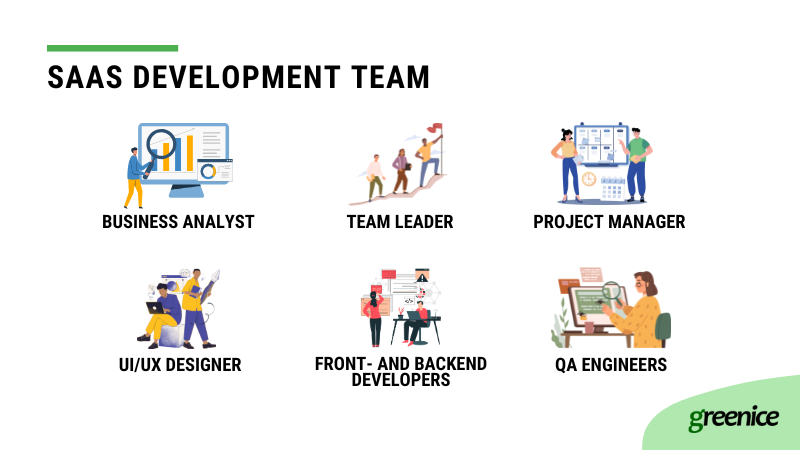
Besides a business analyst, you will also need other specialists:
- A team leader who will analyze your list of features and choose the most suitable technology stack and project architecture.
- A Project manager who coordinates the work of all the team members.
- UI/UX designer for creating a beautiful and usable user interface.
- Front- and backend developers who build the SaaS product.
- QA engineers will test the system in the pre-launch stage to make sure that it satisfies the requirements and has no bugs.
The number of team members depends on the number of tasks and their complexity. For example, you may come to us with a ready design, or you can use a cost-saving design template. Some projects need only backend or only front-end developers. Of course, there are many options and we handle each case individually.
Need help with project specifications for a SaaS product?
Contact Us6. Create a design
The design process for your SaaS startup encompasses two pivotal steps: wireframing and detailed design development, ensuring both functionality and aesthetic appeal.
Developing wireframes: Begin with wireframing, which sketches out the basic layout of your app's interface. This early blueprint allows for cost-effective iterations on the arrangement and functionality of interface elements. Wireframes are instrumental in usability testing and are typically created using tools like Wireframe.cc or through collaboration with UX/UI specialists. At this stage, a professional design is not necessary, allowing even business owners to undertake wireframing. But, naturally, you can hire a designer too and explain your vision. Wireframes set the groundwork for more detailed design by establishing a clear structure without committing to specific stylistic choices.

Transitioning to detailed design: After wireframes are ready, the designer proceeds to refine these layouts into detailed, visually engaging designs that enhance user experience. This step transforms basic sketches into rich, interactive designs, akin to finalizing architectural plans before construction.
Efficiency and iteration: In a startup environment, balance the urgency of launching your product with the necessity of a thoughtful design that supports its core functionality. Initially, prioritize designs that facilitate quick market entry and user feedback. Refine your design in later stages based on this feedback to better meet user needs and market demands.
By methodically tackling design through wireframing and detailed development, and emphasizing mobile-first considerations, your startup can effectively communicate its value and adapt to user feedback, laying a robust foundation for future enhancements.
7. Choose the tech stack
Choosing the right technology stack for your SaaS application involves evaluating several critical factors to ensure the technology aligns with your project's specific requirements. Factors include:
- Performance requirements: Technologies are selected based on their ability to handle the expected load and performance criteria of the application.
- Security needs: Prioritization of technologies that offer robust security features to protect data and transactions.
- Integration capabilities: Technologies that offer ease of integration with other systems and APIs.
- Cost and licensing: Consideration of open-source solutions which generally reduce costs versus proprietary software which may offer more dedicated support but at a higher expense.
- Developer availability and cost: Popular technologies might offer a larger pool of developers, potentially lowering hiring costs, whereas niche or less popular technologies might lead to higher salaries due to the scarcity of skilled developers.
Based on these criteria, here's how various technologies stack up in different areas of a SaaS architecture:
| Purpose | Technologies | Things to consider |
| Front-end | JavaScript, React, Vue | Usability, responsiveness, browser/device compatibility |
| Back-end | PHP, Python, Ruby | Security, processing efficiency, integration |
| Databases | PostgreSQL, MySQL, MongoDB | Data handling needs, performance |
| Infrastructure | AWS, Google Cloud, Azure | Scalability, security, cost, data regulation compliance |
This structured approach ensures that each component of your technology stack is optimized for specific functions within your SaaS application, from managing user interactions on the frontend to processing data on the backend. Selecting the right technologies based on these comprehensive criteria ensures your application is scalable, secure, and cost-efficient, while also being supported by a sufficiently large pool of developer talent.
8. Iterate fast & pivot when needed
The ability to rapidly adapt based on user feedback and shifts in the market is crucial for SaaS founders. This flexibility is essential to refine the product continuously and ensure it remains aligned with user needs and market demands.
Tools to facilitate rapid iterations:
- Agile methodologies: Implementing agile practices such as Scrum or Kanban allows for the structured release of features in sprints. This approach not only helps in quickly rolling out new functionalities but also in gathering user feedback systematically. The feedback can then be swiftly incorporated into future development cycles, ensuring the product evolves in direct response to user needs.
- Continuous integration/Continuous deployment (CI/CD): By employing CI/CD pipelines and adhering to DevOps best practices, updates can be deployed efficiently without significant downtime. This technical setup enhances the ability to make frequent iterative changes that are seamless from a user perspective, reducing the risk of disrupting the user experience while improvements are made.
While the impulse might be to continually add more features, it’s important to focus on the quality rather than quantity of functionalities. Maintaining simplicity in the application can enhance user satisfaction and usability. The mantra "less is more" is often effective, as it prevents the product from becoming overly complex and difficult to navigate.
In summary, the partnership with a development agency skilled in agile methodologies and equipped with robust CI/CD capabilities can significantly boost a SaaS company's ability to adapt swiftly and effectively. This adaptability is key to staying relevant and competitive in the fast-paced tech landscape.
Growth hacking strategies for SaaS
As a founder you need to seek cost-effective, data-driven strategies to acquire and retain users. A development agency can play a pivotal role in facilitating these growth hacking strategies by leveraging technology to optimize marketing efforts. So what are those growth strategies?
- Implementing referral and affiliate programs: Development agencies can set up systems to track referral codes and invites, integrating reward logic directly into the backend. This approach encourages existing users to bring in new users by offering them tangible benefits, effectively lowering the Customer Acquisition Cost (CAC) and enhancing Customer Lifetime Value (LTV).
- Creating viral loops: By building features that promote in-product sharing or embedding—such as integrations similar to those seen with Slack or Zapier—agencies can help your SaaS product leverage viral marketing techniques. This not only increases user engagement but also broadens your product’s reach without significant advertising expenses.
- Optimizing through landing pages and A/B testing: Rapid deployment of various landing pages allows for dynamic testing of marketing approaches to see which elements convert best. Development agencies can facilitate both server-side and client-side A/B tests, providing insights that can directly influence the design and functionality of your pages to improve conversion rates.
Monitoring key performance indicators (KPIs):
.png)
- Monthly or annual revenue: Tracks the income your SaaS generates, giving you a direct insight into its financial health.
- Customer acquisition cost (CAC): Measures the cost involved in acquiring each new customer, crucial for evaluating the efficiency of marketing strategies.
- Customer lifetime value (LTV): Estimates the total revenue a customer will generate during their association with your service, helping to strategize long-term engagement efforts.
- Net promoter score (NPS): Gauges customer satisfaction and their likelihood to recommend your product, which can be pivotal for organic growth.
- Customer churn rate: Indicates the percentage of customers discontinuing their subscription, a critical metric for assessing customer retention strategies.
By strategically applying these tech-driven marketing techniques and regularly reviewing critical metrics, SaaS companies can enhance their market presence, improve user satisfaction, and ultimately boost their profitability and sustainability in the competitive digital marketplace.
Should you migrate your app to SaaS?
Deciding whether to migrate your application to a Software as a Service (SaaS) model involves evaluating several key factors to determine if the transition aligns with your business goals and customer needs. Here are some points to consider:
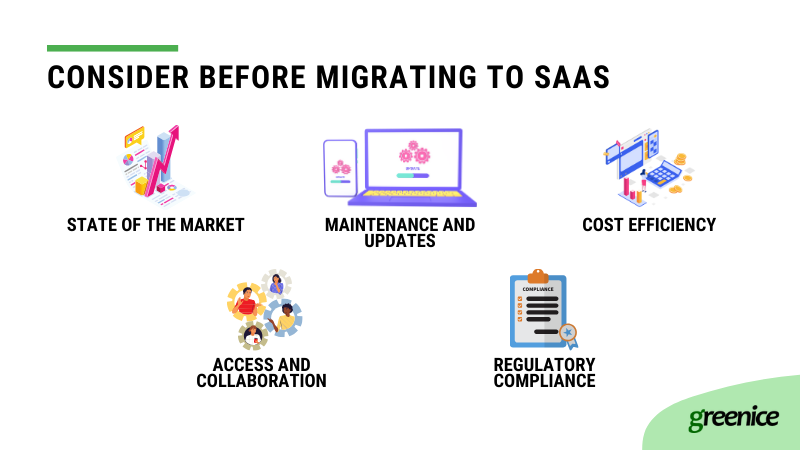
- State of the market: Before migrating your app to a SaaS model, it's essential to conduct market research. Evaluate whether there is a real demand for your SaaS offering and consider how it will fare against existing competitors. Analyze market trends, customer needs, and competitor strengths to determine if your SaaS solution can effectively stand out and meet market expectations. This crucial step will help clarify whether transitioning to SaaS is a strategic move and how to position your product effectively in a competitive landscape.
- Maintenance and updates: SaaS models simplify the process of rolling out updates and maintenance since changes are made directly on the server and instantly available to all users. If frequent updates are required and you wish to streamline this process, SaaS might be the way to go.
- Cost efficiency: Evaluate the cost implications of maintaining your current infrastructure versus switching to a SaaS model, which typically operates on a subscription basis and reduces the need for heavy upfront investments in hardware and software.
- Access and collaboration: If your app benefits from enhanced accessibility, where users can access it from any device with an internet connection, and if collaborative features are integral, migrating to SaaS could significantly improve user experience and productivity.
- Regulatory compliance: For applications dealing with sensitive data, consider if migrating to SaaS will facilitate compliance with data protection regulations, as many SaaS providers offer robust security measures and compliance certifications.
However, if your application requires extremely specialized hardware, operates in an industry with strict data control regulations that a third-party SaaS provider cannot meet, or if the current setup provides a unique competitive advantage that would be lost in a SaaS environment, it may be better to maintain the application as it is. Evaluate these factors carefully to make a well-informed decision about migrating to SaaS.
How much does it cost to build a SaaS platform?
The cost of building a SaaS product varies widely based on several key factors. Here's a breakdown of the primary elements that influence development costs:
.png)
- Features complexity: The more complex the features you want to implement, the higher the cost. Advanced functionalities like real-time analytics, custom user roles, or complex data visualizations require more development time and expertise.
- Integrations: Costs increase with the need to integrate with third-party services, such as payment gateways, CRM systems, or other APIs. Each integration can present unique challenges depending on the compatibility and complexity of the external systems.
- Scalability: Designing a system that can efficiently handle an increasing number of users and data volume without performance loss involves sophisticated architecture, which can elevate costs.
- Development approach:
- From scratch: Building a SaaS application from the ground up provides a fully customized solution but is the most expensive option due to the need for extensive planning, development, and testing phases. This approach allows for tailored architecture and unique features that precisely meet specific business needs. This option will cost from $15,000 for an MVP.
- White-label solutions: Opting for white-label solutions, which use pre-written code scripts, can significantly reduce costs. These are not unique but are highly customizable to a certain extent. This approach is faster and less expensive than developing from scratch, as the basic structure and some features are already in place and only need to be adjusted to fit specific requirements. In this case, MVP will cost from $10,000.
- Hourly rates: The hourly rates charged by the development team significantly influence the cost of creating a SaaS application. These rates vary based on geographical location, expertise, and the complexity of the work required. Developers in regions like North America and Western Europe typically command higher rates due to higher living costs and market demands, whereas those in regions like Eastern Europe or Asia may be more affordable. Additionally, experienced specialists often charge more than junior developers. At Greenice, the average rate is set at $30 per hour.
Each project is priced individually, taking into account all the above factors. When planning a SaaS application, it's crucial to work with developers who understand your business needs and strive to find cost-effective solutions without compromising on quality and scalability.
Our experience
At Greenice, we have a strong track record of developing tailored SaaS solutions that streamline complex business processes and enhance operational efficiency. Our experience spans across various sectors, including healthcare and construction, with notable projects like our HRMS for a home healthcare agency and Toolsey.com for construction companies. The couple of projects below are a good example of vertical solutions that address unique industry-specific needs, which generic HR and CRM systems often fail to meet.
HRMS for healthcare
We developed a comprehensive Human Resource Management System (HRMS) to address the high turnover rates and recruiting challenges faced by our client in the home care industry. Our solution included an applicant tracking system, HR management, online training, and an employee portal, all built from the ground up. Utilizing Amazon Web Services, we ensured robust, scalable storage and processing capabilities to manage large volumes of sensitive data. This system significantly improved the recruitment, onboarding, and management processes, automating many routine tasks and securely managing sensitive data, which helped the client scale their operations efficiently.
CRM system for a construction sector
For the construction sector, we created Toolsey.com, a CRM system that aggregates leads from various sources like HomeAdvisor and Angi. This platform helps companies manage customer information, appointments, and communications effectively. It features integrations with services like Quickbooks and Dropbox, enhancing functionality and user experience. Starting with a small task, the project expanded as more integration needs were identified, demonstrating our flexibility and responsiveness to client needs.
Both projects highlight our ability to create customized SaaS solutions that not only meet specific client requirements but also offer scalability, integration with third-party services, and comprehensive data management. These capabilities ensure our clients can offer their systems as SaaS solutions to other organizations, potentially opening new revenue streams.
Conclusion
The success of a SaaS startup depends on strategic planning and execution across several key areas. From validating the viability of your idea through meticulous market research and clear understanding of your target audience, to choosing the right technology stack that aligns with your business needs while considering cost, scalability, and security. The development process should focus on building a Minimum Viable Product that prioritizes core functionalities to quickly test market assumptions. Additionally, implementing agile development practices can facilitate rapid iterations and pivots based on user feedback, essential for refining the product and maintaining competitive edge.
Employing growth hacking strategies such as referral programs, viral loops, and optimized landing pages can drive user acquisition and retention without substantial budgets. Monitoring essential KPIs like monthly revenue, CAC, LTV, NPS, and customer churn rate is crucial to understand the health and success of the product, informing strategic decisions that enhance profitability and sustainability.
For those looking to embark on a SaaS venture or refine their existing offerings, leveraging a development agency that understands these dynamics can be invaluable. If you're ready to transform your SaaS idea into a successful product, consider partnering with a team that can bring technical expertise and strategic insights to the table. Let's start building your SaaS solution today!
Let's start your SaaS project!
Get a Free Quote Now!FAQ
What are cloud-based SaaS applications? Cloud-based SaaS (Software as a Service) applications are software products accessible via the internet, allowing users to use software without installing it on their local devices. These applications are hosted on cloud servers, which handle the software's data processing and storage, providing users flexibility to access the service from anywhere with an internet connection.
Is it difficult to build a SaaS? Building a SaaS can be complex, depending on the specific requirements and scope of the product. It involves multiple stages including market research, defining a value proposition, choosing the right technology stack, and iterative development with ongoing testing and feedback. Successful SaaS development requires a combination of technical expertise, strategic planning, and continuous improvement based on user feedback.
How much does it cost to build a SaaS software? The cost of building a SaaS software varies widely based on several factors, including the complexity of the application, the technology stack used, and the geographic location of the development team. At Greenice, initial development costs start from $15,000 for an MVP, but the price will be higher for a full-featured application. Ongoing costs will also include server hosting, maintenance, marketing, and continuous development.
How long does it take to build a SaaS product? The time required to build a SaaS product can vary significantly based on its complexity and scope. A simple MVP might take 3 to 6 months to develop, whereas a more comprehensive solution could take over a year. The development process can be extended further based on the feedback received during initial releases and the subsequent iterations needed to refine the product.
Can SaaS integrate with other tools and systems? Yes, SaaS applications can integrate with various other tools and systems, enhancing functionality and user experience. Most SaaS platforms offer APIs (Application Programming Interfaces) that facilitate seamless integrations with other software, ranging from CRMs and ERPs to email marketing services and analytics tools. These integrations can automate workflows, sync data across platforms, and extend the capabilities of the SaaS product.
What are the main challenges in SaaS development? The main challenges in SaaS development include ensuring data security, managing multi-tenancy architecture, achieving scalability, and providing continuous updates and support. Each of these areas requires careful planning and robust technical strategies to handle effectively. Additionally, maintaining a competitive edge in a rapidly evolving market is a constant challenge for SaaS developers.
Rate this article!
5







 Sign in with Google
Sign in with Google
Comments (0)